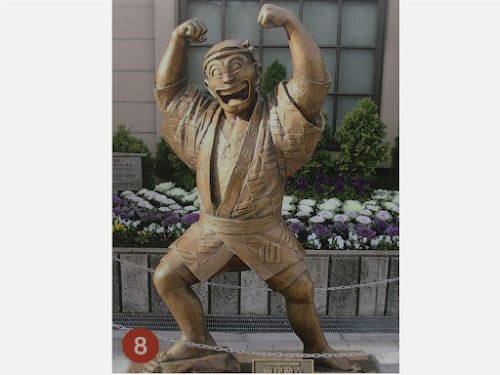Takaoka is 40km away from Kanazawa. Kaga-han, which capital was Kanazawa, also ruled this region in the Edo period. Toshinaga Maeda, who was the second-generation of Maeda clan which was a head (daimyo) of Kaga-han for generations, built a castle for his retirement in 1609. He invited foundry craftsmen to build the castle, and foundry became the local industry. Plus, Kaga-han’s policy, which prioritized art crafts and culture, is the base of the development of Takaoka, so people respect T. Maeda even now.
Reference about Kanazawa and Kaga-han: Ishikawa Prefectural Museum of History 石川県立歴史博物館
高岡は、加賀百万石の二代目、1609年に前田利長が隠居城を置いて、その繁栄がはじまった。利長(市内の表記は利長公)は、築城で必要なこともあって、鋳物師を城下に集め、鋳物が地場産業になった。加賀藩の工芸、文化を重んじる政策が今に生きている。江戸初期に一国二城は禁止され、高岡城は6年後には廃城となった。町は、前田利長リスペクトに溢れている。
Takaoka Municipal Museum 高岡市立博物館
Takaoka Municipal Museum is in the ruined castle park.高岡市立博物館は古城公園内にある。
 |
| Takaoka Municipal Museum 高岡市立博物館 |
Special
exhibition: Letters of T. Maeda、特別展:前田利長書状展
We could
take photos of his letter (historical documents); it was amazing for me.古文書なのに撮影可能でありがたい。
 |
He was
the most powerful daimyo; his letter was well-mounted.
さすがに大大名の書状、美しい表装されている
|
 |
This is
the letter to invite foundry craftsmen to Takaoka. They moved and received
favorable treatment. 砺波・金屋の鋳物師を高岡に招集した書状。鋳物師たちは高岡の金屋町に居を移し、優遇を受けながら製造に励む
|
The
second exhibition room、第二展示室
It shows
the local industry and folklore. Many metal products are exhibited.産業や民俗に関する展示。金属製品がずらりと並ぶ。
 |
Temple
gong “Waniguchi” which was made in 1618; perhaps the oldest metal product in
Takaoka. 1618年製造の鰐口(お寺や神社に吊るす鐘)。高岡金屋の最古の製品の可能性があるという。
|
 |
Bronze
statues are delivered across Japan. Anime character “Ryotsu”, which was
installed in front of Kameari station in Tokyo, was also made here. 銅像は日本全国に置かれているが、東京・亀有駅前の両津勘吉像もその一つだ。
|
 |
The masterpiece
is Takaoka Daibutsu.
代表作は高岡大仏(実物)
|
 |
The
first exhibit of festivals is “Mikuruma festival”; I will introduce this
festival soon. 祭の展示の一番手は、御車山祭。こちらは、御車山会館のページにて紹介します。
|
 |
Masks
of lion dances which are held in each place
獅子舞の獅子頭。高岡各地で行われています。
|
 |
Portable
room lantern in the everyday article area. Convenient.
民具コーナーの持ち運びできるあんどん。便利そう。
|
The first
exhibition room、第一展示室
The history
is exhibited understandably.高岡の歴史に関して丁寧に展示されている。
 |
You can
take a photo with putting on the helmet
前田利長の兜をかぶって写真を撮れるコーナー
|
 |
Inner
moat and Chouyou bridge of Takaoka castle
高岡城内堀の朝陽橋
|
 |
| The ground of the ruined castle tower. 本丸広場 |
Official website: https://www.e-tmm.info/ (in Japanese) , accessed in September, 2020
Takaoka Casting Museum 高岡鋳物資料館
The museum in Kanaya-cho where T. Maeda gave the land to the invited craftsmen. It is a calm town.前田利長が金物職人を集め、特権を与えて住まわせた金屋町に資料館があります。落ち着いています。
 |
| Lattice is beautiful 格子が美しい |
 |
| Takaoka Casting Museum 高岡鋳物資料館 |
 |
Machines
and tools are exhibited inside.
足を踏み込むと、鋳物の道具が並べられている。
|
 |
Model
of T. Maeda’s helmet is shown, he couldn’t put this on probably.
前田利長の兜の鋳型も。これは、戦では被れない。
|
 |
Entrance
of the museum building
鋳物資料館の玄関は町家の奥にあります
|
The area
of the exhibition room is same as a classroom. Temple gong “Waniguchi”, which
was made in 1619 and designated as a Takaoka cultural asset, is exhibited.
展示室は教室ぐらい。市指定文化財の鰐口、元禄9年(1696)の銘があり、これも高岡鋳物で最も古いものと言われている。(お寺の写真は布施弁天/千葉県柏市) |
This
vase is made of metal and coated by lacquer for antirust which is called “Kin(gold)-胎(fetal sac). It is beautiful. 金属の素地に漆を塗って防錆した金胎(きんたい)漆器の花瓶。美しい。
|
 |
Lunch
at Wako in Kanaya-cho. It’s beautiful and delicious. 金屋町の和輝さんで頂いたランチセット。こちらも美しく、美味しい。
|
Official website:
https://www.city.takaoka.toyama.jp/syoubun/kanko/bunka/shisetsu/imono.html
(in Japanese) , accessed in September, 2020
Foundry
company “Nousaku” in Takaoka area gathers 120 thousand customers a year. It is famous for its
factory tour and trial production.
鋳物会社の能作(のうさく)は、工場見学と体験が有名。年間12万人が訪れる。
https://www.nousaku.co.jp/en/factory/
(in English)
https://www.nousaku.co.jp/factory/sightseeing/
(in Japanese)
Zuiryuji temple、瑞龍寺
Approach to Zuiryuji which was built for T. Maeda. This road links the temple and the tomb of T. Maeda, and it is called “Hacchou(around 870 meters) -michi(road)”. The temple is designated as National treasure.高岡、というか、富山県唯一の国宝、瑞龍寺への道、八丁道。前田利長の墓と菩提寺を結ぶ。
 |
There
is a bus in front of the temple. Doraemon is a driver because the cartoonists “Fujiko.F.Fujio
was born in Takaoka. お寺のバスには、ドラえもんが乗ったバスがある。作者の藤子・F・不二雄は高岡生まれだ。
|
 |
| Sanmon gate、山門 |
 |
| Butsuden hall、仏殿 |
 |
| Inside the Butsuden hall、仏殿内部 |
 |
| Hatto hall、法堂 |
 |
| Inside Hatto hall, incredible! 法堂内部、素晴らしい。 |
 |
View of
Oguri(center) and Butsuden(right) from Hatto hall
法堂から仏殿と大庫裏を望む
|
 |
Corrido
to Zendo where monks exercise Zazen (Zen sitting meditation)、禅堂への回廊
|
 |
| Inside the Zendo、禅堂内部 |
 |
The belly
of the fish-shaped wooden gong is gouged. It informs us the time. 時を知らせる木魚がえぐれている
|
Appendix:
Train from Kanazawa to Takaoka “Toyama Emaki(picture scroll)
付録:金沢から高岡への普通列車、富山絵巻 |
Specialties
of Toyama is depicted on each car. I got on the car of Buri fish (adult
yellowtail) 各車両に富山の名産が描かれているが、私が乗ったのは“氷見のぶり”の絵でした。マンボーかと思った。
|
 |
The
Buri fish is also depicted on the seats. But the window view is not good. シートにもブリの絵。でも窓から外は見にくい。
|
Visited in August, 2019
Previous post (Folklore museum in Kanazawa):
Kanazawa Folklore Museum 金沢くらしの博物館
Next post (Festival museum in Takaoka):
Takaoka Mikurumayama Museum 高岡御車山会館








Comments
Post a Comment